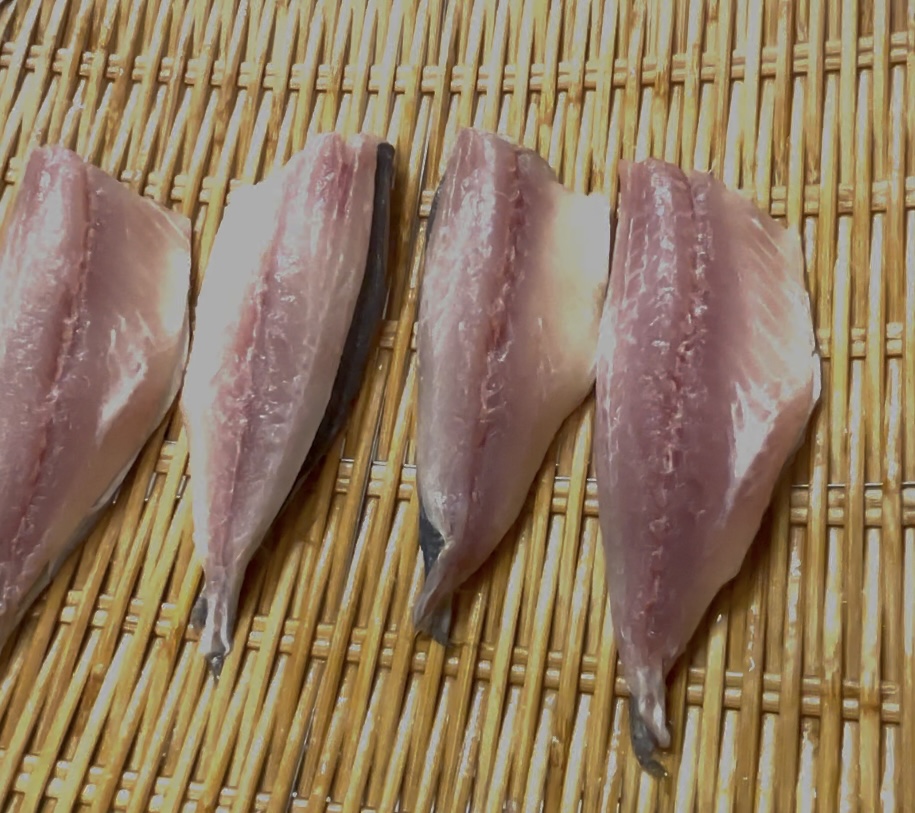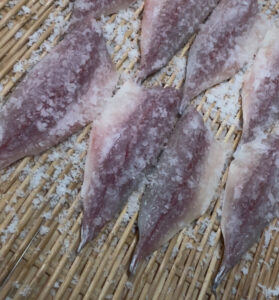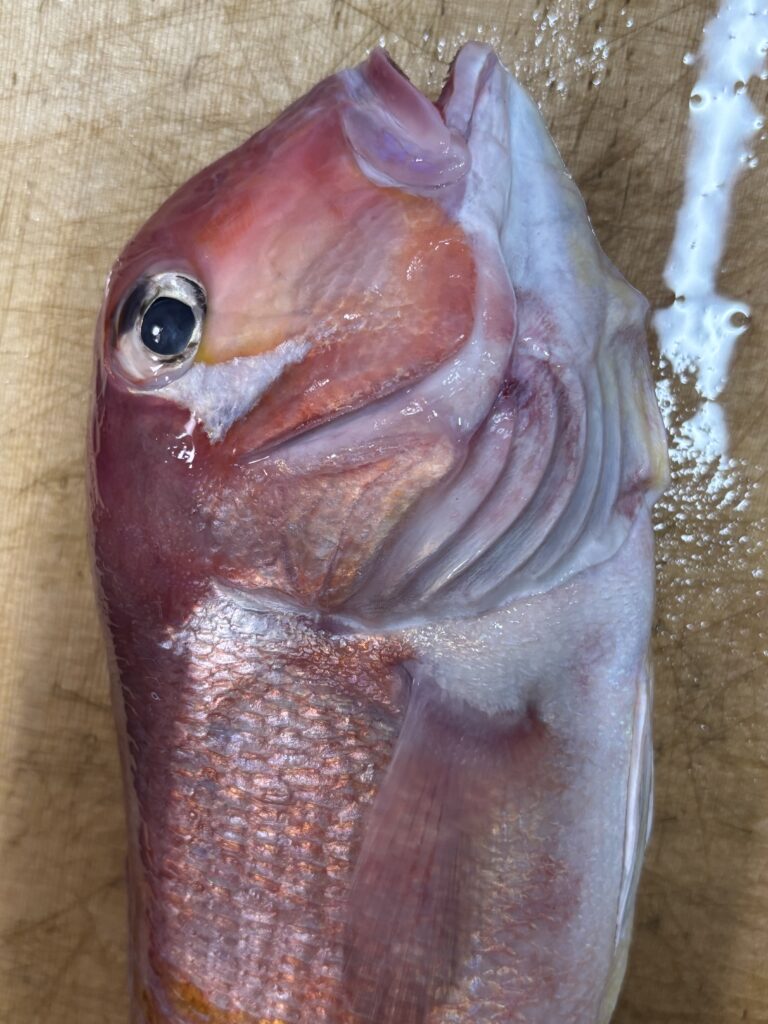
Aji (horse mackerel): Instead of Muro-aji or Ao-aji, we recommend using Ma-aji.
A classic Edomae technique passed down through generations
Contents
- 1 What Is Aji (Horse Mackerel) in Japanese Sushi?
- 2 What Does “Vinegar-Marinated” Mean?
- 3 Choosing the Right Aji
- 4 How to Fillet Aji for Sushi (Three-Piece Method)
- 5 Ingredients (Home-Friendly Version)
- 6 Step-by-Step: How to Marinate Aji in Vinegar
- 7 Serving Suggestions
- 8 Pro Tips from the Master
- 9 Troubleshooting
- 10 Aji vs. Saba: What’s the Difference?
- 11 Conclusion: A Refreshing Bite of Tradition
What Is Aji (Horse Mackerel) in Japanese Sushi?
Aji, or horse mackerel, is beloved in Japanese cuisine for its bright umami flavor, gentle oiliness, and seasonal charm. Especially popular in summer and early autumn, Aji’s firm, sweet flesh makes it a standout in both raw and vinegared sushi. In traditional Edomae sushi, Aji is often sujime—lightly salted and marinated in vinegar—to enhance flavor and ensure food safety.

What Does “Vinegar-Marinated” Mean?
The sujime process involves:
- Sprinkling salt on the fillet to draw out moisture and tighten texture.
- Light vinegar soak to add brightness, preserve freshness, and tenderize the flesh.

This is not long-term curing—it’s a short marination technique, perfect for delicate fish like Aji, Saba, and Kohada.
Choosing the Right Aji
Look for these signs of freshness:
- Clear eyes (not cloudy)
- Firm flesh with natural shine
- Rounded back, shoulder, and neck
- Scales still slightly attached
Tip: Fresher Aji tends to have more scales. Aji caught with nets (as sold in most markets) may have fewer scales but softer flesh—trickier to handle.
How to Fillet Aji for Sushi (Three-Piece Method)
- Remove the head
- Gut the fish (cleanly remove internal organs)
- Take off the “zeigo” – the hard scale-line along the side
Tip for beginners: You can peel the zeigo together with the skin after vinegar marination. - Fillet into three parts – two fillets and the backbone
Use a sharp knife and take your time. The softer the fish, the more delicate your cuts need to be.
Ingredients (Home-Friendly Version)
| Ingredient | Amount (for 2 fish) |
|---|---|
| Salt | ~30g |
| Rice Vinegar | 100–150 ml |
| Water | 50–75 ml (vinegar:water = 2:1) |
| Sugar (optional) | 1 tbsp |
| Optional | Sushi rice, wasabi, shiso, ginger |
Important: Vinegar doesn’t kill parasites like Anisakis. Always freeze the fillets for at least 48 hours before preparing.
Step-by-Step: How to Marinate Aji in Vinegar
1. Salt the Fish
Sprinkle salt evenly on both fillets. Let them rest for 20–30 minutes to firm up and extract moisture.
2. Rinse and Dry
Lightly rinse off the salt with cold water. Pat dry with paper towels.
3. Vinegar Marination
Soak the fillets in a 2:1 mix of rice vinegar and water.
Marinate for 10–15 minutes, adjusting based on thickness.
Add sugar if you prefer a gentler finish.
4. Peel the Skin
From the head side, peel off the silver skin gently with your fingers or tweezers.
Serving Suggestions
- Nigiri: Place a thin slice of vinegared Aji over a ball of sushi rice with a touch of wasabi.
- Temari Sushi: Form bite-sized round rice balls and top with Aji slices—great for parties or bentos.
- Oshizushi (Pressed Sushi): Use a wooden mold to layer rice and Aji for a stunning presentation.
Add shiso, grated ginger, or finely sliced green onion for aroma and balance.
Pro Tips from the Master
- Don’t skimp on vinegar—the fish should be fully submerged.
- Adjust time based on temperature, oil content, and season.
- For beginners, mackerel (saba) follows nearly the same process but is oilier and needs a stronger soak.
Troubleshooting
- Too sour? Reduce marination time or dilute the vinegar more.
- Mushy texture? Likely over-marinated or under-salted.
- Fishy smell? Use only very fresh fish and clean your tools thoroughly.
Aji vs. Saba: What’s the Difference?
| Feature | Aji (Horse Mackerel) | Saba (Mackerel) |
|---|---|---|
| Flavor | Light, clean | Rich, bold |
| Texture | Tender, delicate | Fatty, firm |
| Marination Time | Short (10–15 min) | Longer (30–60 min) |
| Popular Use | Sushi, sashimi | Sushi, grilled, cured |
Conclusion: A Refreshing Bite of Tradition
Vinegar-marinated Aji sushi is a perfect balance of acidity, umami, and craftsmanship. Whether you’re a sushi lover or a curious home cook, this elegant technique connects you to centuries of Edomae sushi wisdom—with just a few ingredients and a sharp knife.
Ready to taste tradition? Try making it at home—your sushi journey begins here.


